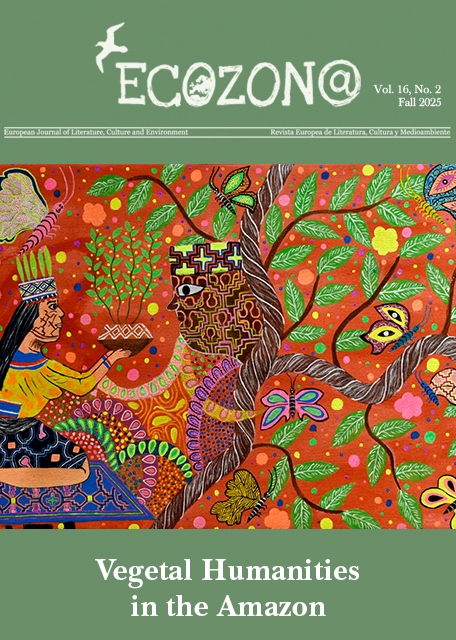<b>Where the Twin Oceans of Beauty and Horror Meet: An Aesthetic Analysis of Annie Dillard's <i>Pilgrim at Tinker Creek</i></b> // Donde los océanos gemelos de belleza y horror se encuentran: Un análisis estético de <i>Pilgrim at Tinker Creek</i> de Annie Dillard
DOI :
https://doi.org/10.37536/ECOZONA.2016.7.2.1013Mots-clés :
Annie Dillard, Pilgrim at Tinker Creek, aesthetic experience, beauty and sublime, via creativa, Nature's wholeness // Annie Dillard, Pilgrim at Tinker River, experiencia estética, belleza y sublime, vía creativa, integridad de la naturalezaRésumé
Although Annie Dillard's masterpiece Pilgrim at Tinker Creek (1974) has conventionally been analyzed as a piece of Nature writing embedded in the Thoreauvian tradition, little has been said about the aesthetic concepts that underlie the text and Dillard's entire take on Nature. This research applies the concepts of Baumgarten's “science of sensible knowledge” to the narrator's perceptions in order to demonstrate that Dillard's ultimate message is the acceptance of Nature, even in its seemingly inhuman places. The study begins with the analysis of the structure of the book, which outlines two types of experience of Nature. Thevia positivais related to the aesthetic concept of beauty and to an active participation of the subject in the aesthetic experience of seeing as a verbalization, whereas the via negativais linked to the concept of the sublime and the experience of seeing as a letting go. Furthermore, the analysis employsand develops Linda Smith's valid conclusions (1991) to show how these two paths join in a third mystical and aesthetic path, the via creativa. By leaving the interpretation of natural signs open-ended, Dillard's modern vision enables the author's total acceptance of Nature's freedom, which fosters its beautiful intricacy as well as its horrible fecundity. Thus, Nature's creativity becomes the basis for an aesthetics of Nature's wholeness, which leadshuman beings to embrace the true essence of Nature, freed from anyprejudices.
Resumen
A pesar de que Pilgrim at Tinker River (1974), obra maestra de Annie Dillard, ha sido analizada convencionalmente como una pieza de literatura y medio ambiente incrustada en la corriente Thoreauviana y ha sido estudiada extensivamente, poco atención se le ha prestado a los conceptos estéticos que subyacen la obra y que pueden servir para comprender mejor la opinión de Dillard sobre la naturaleza. Por lo tanto, esta investigación aplica los conceptos de “ciencia del conocimiento sensible” de Baumgarten a la percepción del narrador con el fin de demostrar que el mensaje final de Dillard es la aceptación de la naturaleza, incluso en sus lugares aparentemente inhumanos. El estudio comienza con el análisis de la estructura del libro, que describe dos tipos de experiencia de la naturaleza relacionados con caminos místicos que llevan a Dios, dentro de la teología Neoplatónica. La vía positiva está asociada al concepto estético de la belleza y a la participación activa del sujeto en la experiencia estética de ver, la cual es definida como una verbalización. Por otra parte, la vía negativa está vinculada con el concepto de lo sublime y la experiencia de ver como un dejar ir. Además, el análisis emplea y desarrolla las válidas conclusiones de Linda Smith (1991) para mostrar cómo estos dos caminos se unen en un tercer camino místico y estético, la vía creativa. Al dejar la interpretación de signos naturales abierta, la visión moderna de Dillard permite al autor la total aceptación de la libertad de la naturaleza, lo que fomenta su hermosa intrincación, así como su horrible fecundidad. Así, la creatividad de la naturaleza se convierte en la base para la estética de la naturaleza en su totalidad, lo que lleva a los seres humanos a aceptar y respetar la verdadera esencia de la naturaleza, libre de cualquier prejuicio.
Téléchargements
Téléchargements
Publié-e
Numéro
Rubrique
Licence
Authors who publish with this journal agree to the following terms:
a) Authors retain copyright and grant the journal right of first publication with the work simultaneously licensed under a Creative Commons Attribution License that allows others to share the work with an acknowledgement of the work's authorship and initial publication in this journal (CC BY-NC for articles and CC BY-NC-ND for creative work, unless author requests otherwise.
b) Authors are able to enter into separate, additional contractual arrangements for the non-exclusive distribution of the journal's published version of the work (e.g., post it to an institutional repository or publish it in a book), with an acknowledgement of its initial publication in this journal.
c) Authors are permitted and encouraged to post their work online (e.g., in institutional repositories or on their website) prior to and during the submission process, as it can lead to productive exchanges, as well as earlier and greater citation of published work (See The Effect of Open Access).










